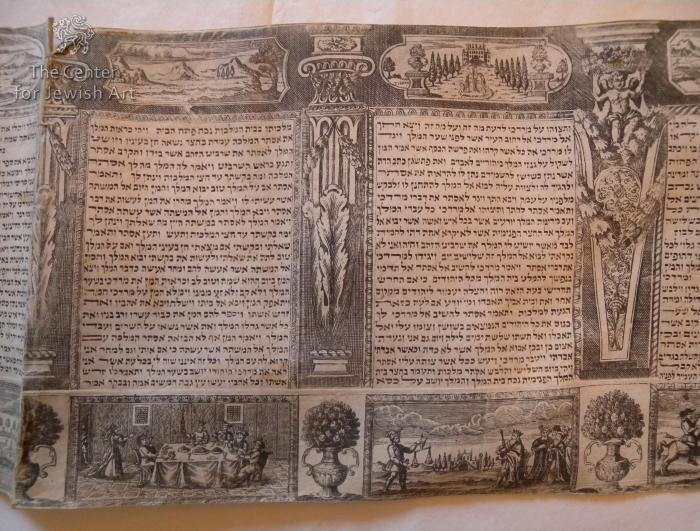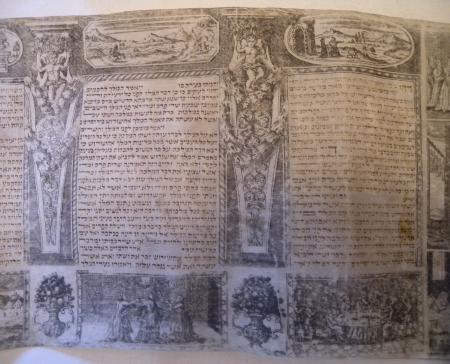Obj. ID: 34764
Hebrew Illuminated Manuscripts MAHJ Esther Scroll with Landscapes I, Amsterdam, early 18th century

The scroll represents the type called "scrolls with landscapes I" (see "Additional Remarks") due to their decorative scheme which features four different landscapes framed in cartouches that fill upper margins and repeat on every sheet in the same order:
1. On the left, two men with a dog standing at the gate are shown against a landscape of mountains and trees that are visible in the background.
2. On the right, two wanderers going towards a hill with buildings. On the left, a man on a horseback riding towards a bridge over a river. In the background, mountains, and trees are visible.
3. A garden with a fountain and a palace in the background.
4. On the right, a man sitting under a tree and, in the background, mountains, trees, and buildings are visible.
It is difficult to show a direct reference between the landscapes and the narrative of the Book of Esther, although such a connection cannot be excluded either (e.g. two men in the second landscape can be the king's messengers and a man sitting under the tree in the fourth landscape can be Mordecai).
The scrolls with landscapes are lavishly decorated megillot produced in a mixed technique in which decorative border is printed as a copper engraving (and in some exemplars, colored by hand), whereas the Hebrew text of the Book of Esther is penned by a scribe. All of them begin with a panel composed of several figurative scenes from the Book of Esther narrative. The text columns are interspaced by herms decorated with reliefs, elaborate acanthus leaves and garlands above which are either decorative capitals or putti holding baskets with flowers on their heads. Lower margins are filled with the figurative scenes that chronicle the Purim story, allude to midrashim or other sources; they are interspersed by vases with plants.
The scroll is stored in a wooden turned and carved case that is 320 mm high and a pull bar of wood is stitched to the right edge of the scroll; it is ca. 215 mm high.
There are two variants of the scrolls decorated with this pattern that in the Index are marked "I" and "II". In some exemplars, just below the decorative columns, the pedestals with angel's heads and bases were added, therefore, the text panels in these scrolls are higher; this type is marked with "II". Whereas, the rest of the manuscripts containing no pedestals with angel's heads and bases are marked with "I". The latter are more numerous.
The earliest scroll sharing a similar engraved pattern is dated to 1701; this is the megillah BCM 25 from the Braginsky Collection in Zurich (see http://braginskycollection.com/esther-scrolls/; accessed on 22.04.2020).
At least 25 manuscripts featuring similar pattern are still extant. For descriptions of other scrolls sharing similar pattern see IDs: 23637, 23758, 23763, 34776, 35188, and 36173.
Similar narrative scenes are included in the scrolls with "portrait medallions" (see in the Index); some of them are their mirror image.
The scroll is on display in the permanent exhibition of the Museum.
The membranes of the scroll are a bit lower than in many other scrolls featuring the same pattern; possibly they were trimmed so the manuscript could fit in the wooden case.
sub-set tree:
| inv. D.98.04.072.CL (former number Cl 12296a)
L | Landscape
C | Columns
A | Acanthus Leaf
G | Garland
P | Putto (Putti in Plural)
B | Basket | Basket with flowers
V | Vase
|
An average letter is ca. 2 mm high except for the letters in col. 14 in which are ca. 6 mm high.
Dimensions of the selected details in the scroll:
- upper margins - 30 mm;
- lower margins - ca. 35 mm;
- a text panel - 92 x 67 mm.
The scroll is formed of 4 membranes containing most likely 16 text columns (during the research, a part of the manuscript remained rolled in the case) which differs in the number of lines between 21 and 25 except for col. 14 that is inscribed in 11 lines divided into two parts. The membranes nos. 1-3 contain 4 text columns and most likely the same number of columns is on the fourth sheet.
The text is inscribed on the flesh side of parchment membranes in a small square script, in dark brown ink (at the beginning of the scroll, the shade of the ink is lighter).
The first word of the Megillah is enlarged. Similarly, the letter ח (Es. 1:6) is enlarged and bolded. Additionally, col. 14 contains enlarged and diminished letters. During the research, the final part of the manuscript remained in the case, therefore, it cannot be determined if the last column includes the letter ת that is highlighted in any way.
Every benediction starts with an enlarged and bolded word ברוך that is written separately in the first line of a particular formula.
The parchment is rather grey and very stiff. The side of the membranes with the decorations and the text is more smooth than the other one that is rather suede.
The ruling is barely visible; it can be discerned in the places where the text is absent and on the blank side of the membranes.
The membranes are stitched but the sewing is not aesthetic.
The scroll is described in:
Victor Klagsbald, Catalogue raisonné de la collection juive du Musée de Cluny, Paris 1981, 63-64, object 72.
A short description in French and a photograph are available on https: https://www.mahj.org/en/decouvrir-collections-betsalel/rouleau-d-esther-50073 (accessed on 30.05.2020).
Other scrolls sharing the same or similar pattern are discussed for example in:
Jiřina Šedinová, From the Mss. Collections of the State Jewish Museum in Prague. The Scrolls of Esther, „Judaica Bohemiae” 1979, nr 15/2, 79-80.
Dagmara Budzioch, The Decorated Esther Scrolls from the Museum of the Jewish Historical Institute in Warsaw and the Tradition of Megillot Esther Decoration in the Seventeenth and Eighteenth Centuries – An Outline [Polish: Dekorowane zwoje Estery z Żydowskiego Instytutu Historycznego w Warszawie na tle tradycji dekorowania megillot Ester w XVII i XVIII wieku. Zarys problematyki], Warszawa 2019, 1:163-176, 2:41-49.
Olga Sixtova, O svitku / Form of the Scroll [katalog k výstavě konané v Galerii Roberta Guttmanna Židovského muzea v Praze od 22. června do 26. července 2006], Prague 2006, 37.
A Journey through Jewish Worlds: Highlights from the Braginsky Collection of Hebrew Manuscripts and Printed Books, eds. Evelyn M. Cohen, Emile Schrijver, Sharon Liberman Mintz, Amsterdam 2009, 234-237.
Schöne Seiten. Jüdische Schriftkultur aus der Braginsky Collection, eds. Emile Schrijver, Falk Wiesemann, Evelyn M. Cohen, Sharon Liberman Mintz, Menahem Schmeltzer, Zurich 2011, 282-283.















